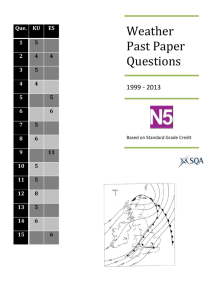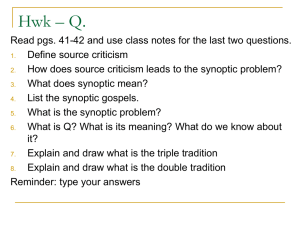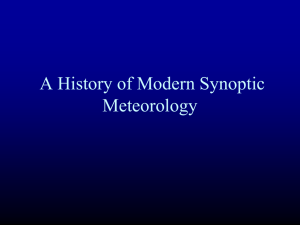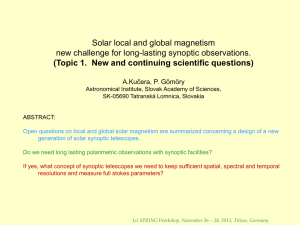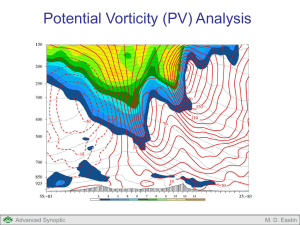Synoptic Method
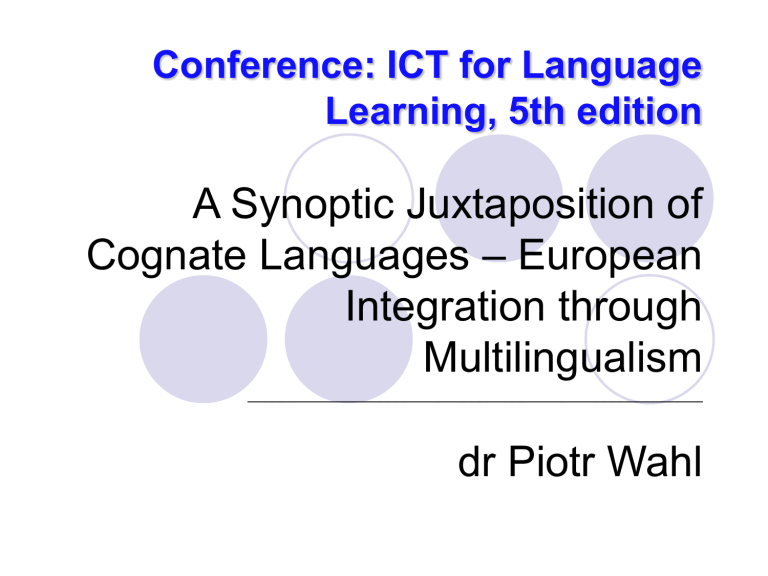
Conference: ICT for Language
Learning, 5th edition
A Synoptic Juxtaposition of
Cognate Languages – European
Integration through
Multilingualism
_______________________________________________________
dr Piotr Wahl
The gift of tongues
On the Pentacost the Holy Spirit descended on the Apostoles and they were given the gift of tongues.
A typical Western image of the Pentecost. Duccio di
Buoninsegna (1308), tempera on wood.
Taken from: http://en.wikipedia.org/wiki/Pentecost
2
The gift of tongues
George Steiner ("After Babel"): was it glossolalia or xenoglossy?
γλωσσολαλία (glossolalia) = γλώσσα
'tongue' + λαλέω 'to speak'; speaking the sacred Pre-Babel language understood by everybody
Ξενογλωσσία (xenoglossy) = ξένος 'foreign'
+ γλώσσα; speaking all possible languages
3
Multilingualism
glossolalia + xenoglossy
(two different facets of the same phenomenon)
= multilingualism
4
Multilingualism...
(1)
is quite unevenly distributed geographically;
(2)
is very differently treated in various parts of the world and by various groups of people.
5
Multilingualism
In the world:
there are not more than 200 countries
and much more than 2,000 languages
(according to some sources there may be even 10,000 languages).
Less than a quarter of the world's nations give official recognition to two languages, and only six recognize three or more.
6
Multilingualism...
...is commonly burdened with two fallacies:
(a) geographically it is a limited phenomenon, and
(b) multilinguals are somewhat handicapped.
Both are false!
7
Multilingualism...
(a) Up to 70% of the world's population may be multilingual;
(b) multilinguals are intellectually much richer.
Conclusion : multilingualism should be supported & promoted
How ?
(1) through a special language policy;
(2) by teaching foreign languages.
8
Achieving native speaker’s competence
language acquisition
≠ language learning
The native speaker’s competence
= the C2 level according to Common
European Framework of Reference for
Languages
9
Language acquisition vs language learning
The (Chomskyan) LAD (language acquisition device) + some critical periods or thresholds.
The LAD = an innate linguistic matrix in which any language may be inscribed.
'innate' = 'genetically recorded information'.
This innate linguistic matrix is activated gradually when some windows are opened; the time when each of these windows stays open is called
'critical period'. When the windows get closed, i.e. the critical periods are over, the acquisition of another language becomes much more difficult, if not impossible.
10
Learning foreign languages in Europe:
3 years at kindergarten...
12 years at primary and secondary schools...
4-5 years at university...
Altogether, up to 20 years.
Can the majority of the European population speak one or more foreign languages fluently?
11
Teaching foreign languages
The answer is:
No.
Logically enough, there appears a question:
Why is it so?
The explanation is obvious
(almost tautological):
Because the existing methods are not efficient.
12
Teaching foreign languages
An ensuing conclusion seems equally obvious: a new, more efficient method must be looked after.
* * *
There may be a method that meets this requirement: the Synoptic Method
13
Synoptic Method
The method called 'synoptic' because the languages taken for analysis are juxtaposed in the same way the
Books of New Testament have been since 1774 (and called 'synoptic
Gospels'). The juxtaposed languages collated so that to emphasise the differences and similarities between them.
14
Synoptic Method
The grammar is operational and consists of 6 sets:
1) phonetic,
2) semasiological,
3) morphological,
4) lexical,
5) syntactic simple,
6) syntactic complex; and four vertical intralingual functions:
1) morphological,
2) lexical,
3) syntactic simple,
4) syntactic complex.
15
Synoptic Method
The infralingual functions, the 'inside-a-language' functions, combine elements of a lower level into units of a higher level up to the finite message.
Synoptic switching between languages possible due to the five horizontal interlingual functions:
1) phonetic,
2) morphological,
3) lexical,
4) syntactic simple,
5) syntactic complex.
16
Synoptic Method
The interlingual functions, the 'between-languages' functions, transform units of one language into units of another language at the same level; for example, at the lexical level the interlingual functions can transform
Spanish words into the Portuguese ones, and vice versa , which may be transcribed in the following way:
F
SPN→POR
L and F
POR→SPN
L
;
F
SPN→POR
L
= {f
1
(habilidad) = habilidade; f
2
(acusación) = acusação; f
3
(noche) = noite;...; f n
(x) = y}
17
Synoptic Method
If another language added – let it be French – the number of the functions of the first order amounts to six:
F
SPN→POR
F
SPN→FRN
F
FRN→POR
L
L
L and F
POR→SPN
L
; and F
FRN→SPN
L
; and F
POR→FRN
L
; and to n functions of the second order:
{f
SPN→POR
1 f
(habilidad) = habilidade;
POR→FRN
1
(habilidade) = habilité; f
= habilité;...}; {f SPN→POR
SPN→FRN f f
POR→FRN
2
SPN→FRN
2
(acusação) = accusation;
(acusación) = accusation;...}
1
(habilidad)
2
(acusación) = acusação;
18
Synoptic Method
The interlingual lexical functions may be compacted to several dozen ones of the 3rd order:
{f
SPN→POR
1
(~dad) = ~dade;
f
POR→FRN
1
(~d ade) = ~té;
f
SPN→FRN
1
(~dad) = ~té;...};
{f
SPN→POR
2
(~ción) = ~ção;
f
POR→FRN
2
(~ção) = ~tion;
f
SPN→FRN
2
(~ción) = ~tion;...}...
19
Synoptic Method
The functions of the first order – not operational.
There may be up to one million interlingual lexical functions of the second order (as it is in the case of the
English language);
these may be compacted to just several dozen ones of the third order.
The same may be done at the other levels: phonetic, morphological and syntactic (simple and complex).
It is a complicated and time-consuming process to record one million bits of information, and so is the process of their retrieval; it is much easier if the number of the bits is reduced to several dozen. The act of speaking is momentaneous and the human mind may be unable to manage the system of functions of the second order.
20
Synoptic Method
The Synoptic Method already applied to a group of languages: Spanish, Portuguese and French; and tested on two groups of students.
The results, is spite of being preliminary and still not quantified, indicate an enormous increase in the effectiveness compared to the existing mainstream methods: using the latter it takes 480 hours to achieve the
B2 level in one language and 1440 in three languages, whereas with the use of the Synoptic
Method the B2 level in three languages may be arrived at after 320 hours, i.e. 4.5 times faster.
21
Synoptic Method
Existing mainstream methods compared to the
Synoptic One:
Existing mainstream methods
One language
Synoptic Method
Three languages
Level hours cumulative hours cumulative hours cumulative
A1 120
A2 120
B1 120
B2 120
120
240
360
480
360
360
360
360
360
720
1040
1440 320
22
Synoptic Method
The theory:
Piotr Wahl; Metoda synoptyczna. Nowa wizja języka etnicznego w aspekcie teoretycznym i aplikacyjnym
(Synoptic Method. A New Vision of Natural
Languages...); 2011; Szczecin University; Szczecin;
ISBN 978-83-7518-313-9; 283 pages.
An example how it may be applied to a group of languages:
Piotr Wahl; Synoptic Description: Spanish, Portuguese,
French; 2010; Szczecin University; Szczecin; vol. 1,446 pages (ISBN 978-83-62355-38-9); vol. 2,450 pages
(978-83-62355-39-6).
23
The European Union’s linguistic policy
The EU's 23 official languages may be divided into:
the Romance ('Neo-Latin') languages: French, Italian,
Portuguese, Romanian, Spanish;
the Germanic languages: Danish, Dutch, English,
German, Swedish;
the Slavonic languages: Bulgarian, Czech, Polish,
Slovak, Slovenian;
the Finno-Ugric languages: Estonian, Finnish,
Hungarian;
the Baltic languages: Latvian, Lithuanian;
the miscellaneous group: Greek, Irish, Maltese.
24
The European Union’s linguistic policy
The Romance languages native speakers could be taught the other 4 Romance languages;
the Germanic languages native speakers – the other 4 Germanic languages;
and the Slavonic languages native speakers – the other 4 Slavonic languages.
In the Schengen space the state borders no longer exist, however they do exist mentally, they are real 'scars of history'; the Synoptic Method could heal these scars.
25
Towards an all-European identity
A change in university curricula; for example, instead of:
the history of Spain,
the history of Portugal,
the history of France,
the history of Italy
(which are sometimes contradictory), there would be one comprehensive history of the Neo-Latin area .
26
Glossolalia
The semasiological set contains the meanings alone, deprived of any forms.
If such meanings could be transmitted from one human mind to another, the gift of glossolalia
(the gift of speaking the pre-Babel language) would become conceivable.
27
Xenoglossy
The Chinese character for 'woman' is:
女 .
This character will induce in anybody who can read the Chinese characters, irrespective of what language they are native speakers of, an image of a woman; thereby, xenolossy
(the gift of speaking all the languages) becomes conceivable.
28
Glossolalia & Xenoglossy
The final conclusion: thanks to the Synoptic Method the Biblical gifts of glossolalia and xenoglossy become imaginable, and there is just one step from what is imaginable to what is feasible.
29
Piotr Wahl may be contacted at:
Akademickie Centrum Kształcenia
Językowego (Szczecin University’s
Linguistic Centre), Ul. Wawrzyniaka 15,
70-392 Szczecin, Poland.
website: www.ackj.pl
e-mail: wahl3@wp.pl
30
